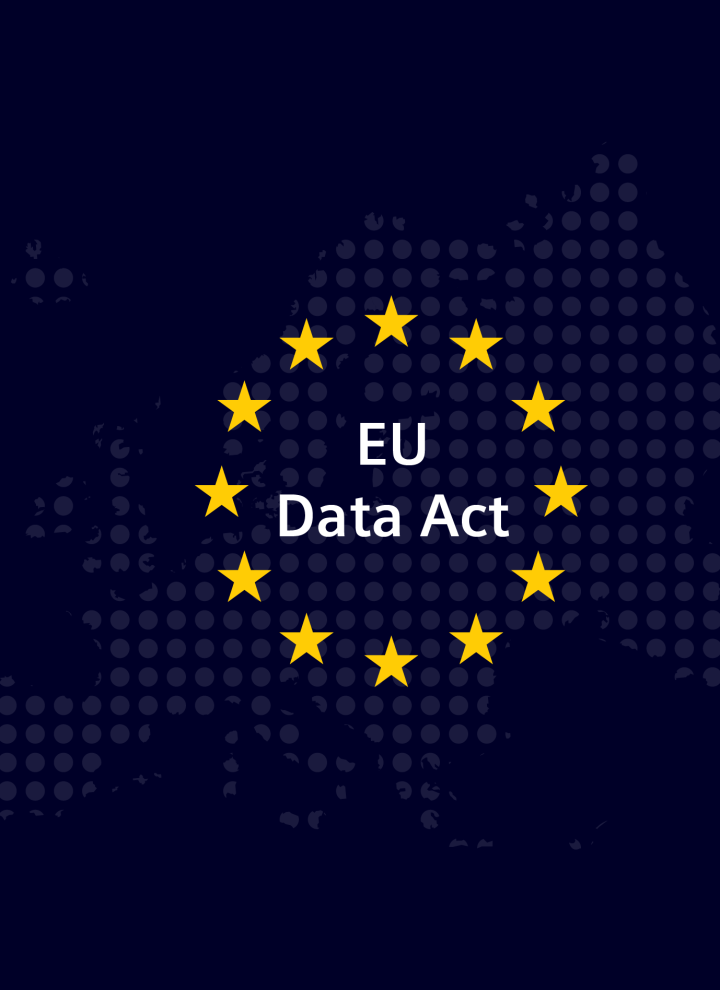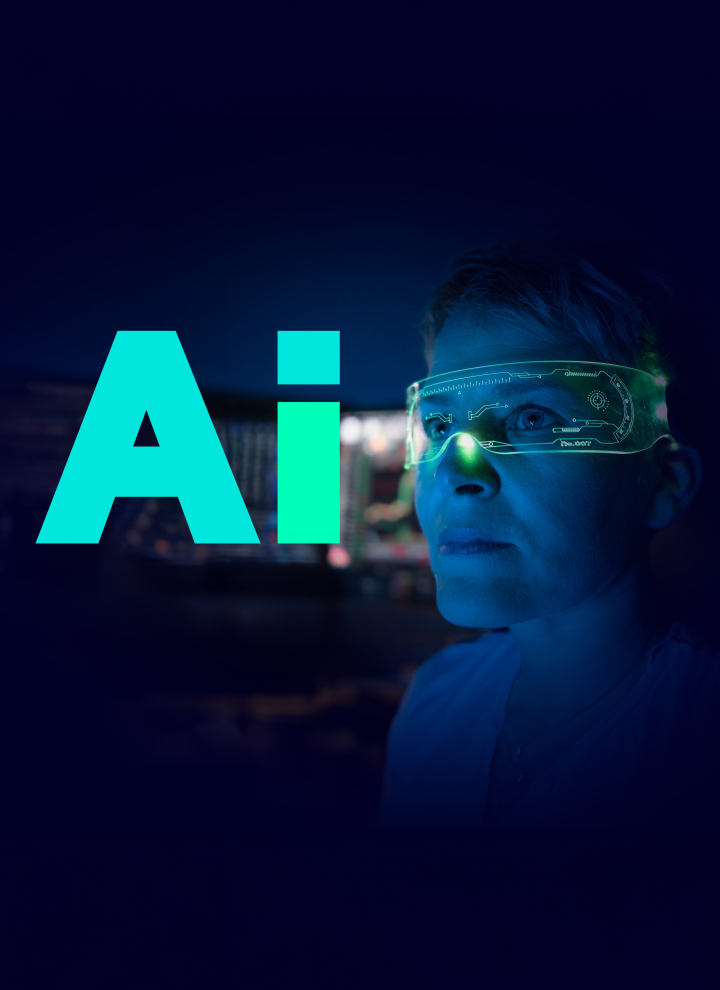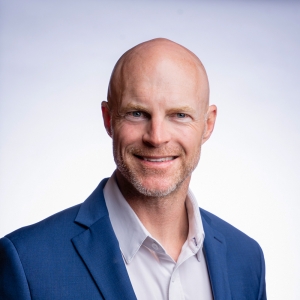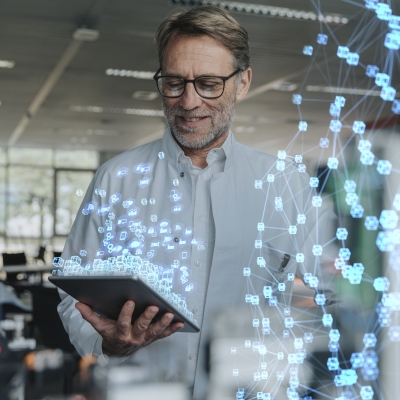Compliance with EU Data Act

Compliance with EU Data Act
EU Data Act: Prepare for New Regulations
To foster the data economy in the European Union, EU legislators are currently reshaping business ground with new laws that shall enable fair and simple access to and use of data. The latest legislation: the EU Data Act, will become effective in September 2025.
With this deadline on the horizon, manufacturers of connected devices and others are required to act now. The timeline is tight, the obligations and requirements are ambiguous and fundamental business questions need to be clarified.
What is EU Data Act?
One important aspect of the EU Data Act is to grant users of connected products the right to access the generated machine data. In addition, the Data Act allows users to grant access to that data to third parties, which may be, for instance, independent service providers, AI startups and potentially also competitors.
Users and third parties may use the data for their own purposes, including providing third party service (as an alternative to manufacturer provided services) or analytics offers.
Manufacturers that fail to provide data access risk facing substantial financial penalties. The penalties shall be effective, proportionate and dissuasive and may have retroactive effect; if personal data is concerned, fines shall be according to the GDPR, which means the higher of EUR 20 million or 4% of the annual global revenue.
What is required and when?
Beside other obligations, manufacturers of connected products need to fulfill three key obligations by two deadlines.
- Information obligation
Starting from September 2025, manufacturers of connected products are required to inform users at point of sales about the data that the connected product generates during usage.
- Data sharing obligation
Starting from September 2025, the data holder (usually the manufacturer, if it chooses to collect the machine data) is required to share available data with the user of the connected product as well as with third parties authorized by the user.
- Design obligation
One year later, starting from September 2026, manufacturers must design new products in a way that the data is directly accessible to the user.
What do these obligations imply? Companies that sell connected products need to react now and start designing and implementing response strategies for sharing the relevant data. Yet, as is often the case, the details are where the real challenges lie.
Who does the law apply to?
The above-mentioned obligations under the EU Data Act apply to all manufacturers of connected products that make their products available in the EU, irrespective of their industry and place of establishment.
The right to access data is restricted to users within the EU. Third parties that were granted access by users must have a legal representation in the EU to be eligible for data access.
How can you become compliant?
The path to compliance is individual for each company, yet there are four key tips, from our experience, to make the journey a smoother one.
- Setting up a cross-functional team
Due to the complexity of this topic, different functions and experts from within the clients’ organization and from external need to be mobilized, including legal, government affairs, R&D, product management and IT. It is advised to involve all experts and concerned business units from day 1 to form a joint response strategy moving forward.
- 80/20 and risk-based approach
The Data Act applies not only to new products, but also to the existing installed base in many cases. Companies with a large variety of product families need to carefully plan their approach to balance the need of being compliant and the effort to implement.
- Close collaboration between legal and technology experts
Companies usually need to develop a new technical solution to fulfill the obligations under the Data Act. It is neither a pure technical nor an entire legal decision. Technical feasibility/effort and legal compliance risks need to be evaluated jointly to come up with an optimal solution. In addition, sales and customer service teams need to be involved as well to ensure a smooth customer experience.
- Treat this as a business opportunity rather than a pure compliance burden
Despite being a compliance topic from the first glance, the EU Data Act also provides vast opportunities for companies to capture. Creating new revenue streams of providing data, offering third party maintenance services for other companies’ products, or conducting AI analytics on competitors’ machine data, the opportunities seem endless.
How can Siemens Advanta help?
With our footprint in various industries and specifically our experience with the EU Data Act, we can support our clients on their way to become compliant with the obligations. Our project management services span from hands-on project management office support for urgent content issues, to developing comprehensive data strategies designed to meet future digital challenges. Siemens Advanta tailors its offerings and strategies to align with the unique needs and stages of development in areas, e.g. system architecture and data literacy, ensuring that our services are well-suited to each client's specific circumstances and objectives.
If you want to learn more about our offerings regarding the EU Data Act, please download the detailed presentation on the topic here:
Industry experts




Disclaimer
The information provided herein is for general informational and promotional purposes only and may not be accurate, complete or up to date. The information does not constitute any regulatory, legal, financial, technical or other professional advice.
No responsibility or liability will be accepted for any errors, omissions or inaccuracies in the content. Siemens Advanta disclaims, to the fullest extent permitted by applicable law, any and all liability or responsibility for the accuracy and completeness of the information contained herein and for any acts or omissions made based on such information. Siemens Advanta does not provide any legal, regulatory, audit, or tax advice; readers are responsible for obtaining such advice from their own legal counsel or other licensed professionals.
AI Newsletter

Spotlight AI
The AI newsletter by Siemens
Welcome to the Spotlight AI
Artificial Intelligence is reshaping our world by driving unprecedented change in business and society. As we enter this new era of innovation, companies are faced with the challenge of adapting quickly to this industrial revolution.
Introducing Spotlight AI, a bi-monthly newsletter curated by Siemens. Our goal is to keep you at the forefront of the AI revolution. We'll deliver:
- Valuable insights from cutting-edge projects
- Expert interviews offering practical guidance
- Strategies to help you and your organization thrive in this evolving ecosystem
Don't get left behind in the AI and digital transformation. Stay informed, stay ahead.
Complete the contact form below to subscribe to Spotlight AI.
Our contributors


Ports

Paving the Path for Tomorrow’s Ports
Witness the Smart and Sustainable Evolution in the Maritime Industry
Navigating operational challenges in a changing landscape
Port and terminal operators are facing increasing challenges which impact day-to-day operations and productivity. In addition to commercial losses due to unplanned downtime and infrastructural damage, Black Swan events and cyber security threats can also affect the ability to attract and retain customers in a competitive market. While consumer reliance on port and terminal services steadily increases, changes to trade policy and customs procedures can cause processing delays and disrupt supply chains. Meanwhile, port and terminal operators are under swift time limits to adopt sustainable practices and comply with new climate and resource regulations.
Convergence of IT and OT
Combining information technology (IT) with operational technology (OT) enables a port to connect, and analyze information and operations, increase transparency and access and leverage data across the product and production lifecycle and throughout the supply chain ecosystem.
By converging IT and OT, data can flow starting vertically from field devices and sensors to edge computing and the cloud. Applying IT and software development methodologies to the OT world and collecting, contextualizing, and leveraging OT data with IT mechanisms makes smart, secure, and sustainable ports a reality.
Empowering your unique transformation every step of the way through our collaborative approach:
Siemens Advanta provides comprehensive digital transformation services combining IT+OT and special custom solutions that leverage the full potential of data by applying industrial-grade trustworthy, robust, and cyber secure technologies for critical infrastructure optimization.
We assist our customers in realizing successful digital transformation through targeted use cases in the following areas:
- Reducing carbon emissions, waste, and pollutants with real-time and historical environment data
- Detecting potential hazards at an early stage and control physical and digital access
- Safeguarding data and systems against cyber threats
- Interconnected Systems: Expanding functionalities and operational efficiency through seamless integration of the existing IT infrastructure
- Monitoring health and status of critical port and terminal infrastructure and optimize asset management and preventative maintenance
- Coordinating and automate workflows from ship arrival to cargo destinations
- Centralizing communication systems across all port systems to improve port management and supply chain operations
At Siemens Advanta, we believe in a people-focused and collaborative approach to client partnerships, utilizing our extensive domain and technology expertise to deliver solutions uniquely tailored to your business needs. Our five-step process ensures that we work closely with your team to build the perfect solution, all within a transparent pricing model.
- Step 1: Problem Discovery and Target Setting
We begin by identifying and defining aligned and detailed objectives to ensure we fully understand your needs.
- Step 2: Prototyping
Next, we create a prototype designed specifically to meet your business requirements.
- Step 3: Proof of Value
We then demonstrate the real impact of the solution to validate its effectiveness.
- Step 4: Productization
Following this, we define a scaled implementation roadmap to bring the solution to life.
- Step 5: Scaling Across the Business
Finally, we scale the solution across your business to ensure widespread benefits.
Together, we build a solution that drives your digital transformation forward.
What we have achieved for our clients
Reduction in time taken for trucks to enter, load, unload, and exit the terminal
Increase in ship calls handled per day
Reduction in unplanned downtime due to cyberattacks or technical issues
Decrease in time for the terminal to resume normal operations after a disruption
Latest Smart Buildings, Campuses & Districts Insights
Our industry leaders



Give us the "green light!"

Give us the "green light!"
Your trust is our motivation - your success our mission.
Continue to give us your trust
Fill out the contact form and give us the "green light" to successfully lead our partnership into the digital age.
After submitting the form, you will receive an e-mail to confirm your details. This consent can be revoked at any time by e-mail or by clicking on the "Unsubscribe" link in received e-mails with future effect.
This way, you will remain informed and will continue to receive relevant information about events, new blog posts & whitepapers and much more. You can, of course, revoke this consent at any time.
We thank you for your trust, and we’re looking forward to continuing our successful collaboration.
Healthcare of the Future

Healthcare of the Future
Enhancing patient care through smart, secure, and sustainable innovations
The healthcare industry stands on the precipice of a transformative era. Smart technologies, automation, and a focus on personalized care are reshaping how we deliver and experience medical services. This article explores these advancements while emphasizing the importance of cybersecurity and environmental sustainability in building a future-proof healthcare system.
Smart innovation use cases in the healthcare industry
The rise of smart technologies and infrastructure
Hospitals are transforming into interconnected ecosystems, where smart devices collect real-time patient data. Wearable technology allows for continuous health monitoring, while Internet of Things (IoT) sensors track vital signs within hospital rooms. This data empowers healthcare providers with a more holistic view of their patients' conditions, enabling proactive interventions and improved decision-making. Additionally, smart infrastructure promises optimized resource allocation, leading to reduced wait times and improved operational efficiency.
Robotic surgeries: advancing precision
Robotic surgery systems are gaining traction, offering minimally invasive procedures with superior dexterity and magnified visualization. These systems allow surgeons to operate through smaller incisions, leading to faster recovery times, reduced pain, and improved cosmetic outcomes for patients.
Automation for efficiency and precision
Repetitive tasks like medication administration and data entry are increasingly being automated. Robotic surgery systems offer minimally invasive procedures with enhanced precision and faster recovery times. Automation not only frees up healthcare professionals for more complex tasks but also minimizes human error, leading to improved patient outcomes.
Personalized medical records: A patient-centric approach
The future of medical records lies in personalization. By leveraging Artificial Intelligence (AI) and Machine Learning (ML), these records will evolve into comprehensive health profiles. These profiles will integrate data from various sources, including wearable technology, genetic information, and past medical history. This allows for tailored treatment plans and preventive care strategies, empowering patients to actively participate in their own health management.
Unveiling hidden patterns for enhanced patient experience
Artificial Intelligence (AI) and Machine Learning (ML) are poised to revolutionize healthcare by providing valuable insights from vast datasets. These technologies can analyze complex medical information to identify patterns and trends that may escape the human eye. This empowers healthcare professionals with data-driven insights for diagnosis, treatment selection, and personalized care planning.
Home care revolution: convenience and accessibility
Advancements in technology are making it possible for patients to receive high-quality care in the comfort of their homes. Telemedicine consultations allow remote patient monitoring and virtual doctor visits. Additionally, remote patient monitoring systems provide continuous health data to healthcare providers, enabling timely intervention when needed. This shift to home care empowers patients to manage their chronic conditions more effectively while reducing strain on hospital resources.
The future of healthcare prioritizes a seamless and positive patient experience. Mobile applications will streamline appointment scheduling, medication reminders, and access to medical records. Additionally, AI-powered chatbots will offer 24/7 support and answer patient queries, enhancing the overall patient journey. These innovations, along with telemedicine, patient analytics, and continuous health monitoring, improve patient care and operational efficiency. The future of healthcare is centered on delivering a positive patient experience and ensuring sustainable and efficient applications in the industry.
Security as a strategic imperative in healthcare
With increased trust in evolving technologies like AI and IoT, the healthcare industry has seen significant benefits but also faces serious risks, such as cyberattacks. Protecting patient data is crucial, as breaches can lead to identity theft or the sale of data on the black market. These malicious attacks can also cripple hospital operations, causing delays in patient treatment. As a result, implementing robust cybersecurity measures, including regular incident response plans and forensic analysis, is essential. This approach ensures patient data remains secure and healthcare operations run smoothly.
Sustainability: A green future for healthcare
Sustainability is becoming a core pillar in healthcare delivery. Hospitals are adopting energy-efficient technologies and implementing water conservation measures. Additionally, waste management practices are being optimized to reduce environmental impact. By embracing innovative technologies, prioritizing patient-centric care, and fostering a secure and sustainable environment, the healthcare industry is poised to usher in a new era of wellness and well-being. This future holds immense potential for enhancing patient care, improving healthcare delivery, and creating a healthier planet for all.
A virtuous cycle that benefits both patients and healthcare providers
The three pillars of smart, secure, and sustainable healthcare work in concert to create a virtuous cycle that benefits both patients and healthcare providers. Smart technologies like AI-powered diagnostics and remote monitoring allow for earlier interventions and more targeted treatment plans, leading to improved patient outcomes. Additionally, automation streamlines administrative tasks and reduces human error, freeing up medical professionals to devote more time to individual patient care. This personalized approach fosters a more positive patient experience, building trust and satisfaction.
Furthermore, the secure pillar safeguards this progress. Robust cybersecurity measures protect sensitive patient data from breaches, ensuring patient privacy and preventing disruptions to critical healthcare operations. This translates to reduced costs associated with data breaches and cyberattacks, allowing healthcare institutions to allocate resources more effectively towards patient care and innovation.
Finally, the sustainable pillar tackles environmental concerns and cost reduction simultaneously. By adopting energy-efficient technologies and waste management practices, healthcare institutions can minimize their environmental footprint while lowering operational expenses. These cost savings can then be redirected towards enhancing patient care and acquiring the latest advancements in medical technology. This holistic approach ensures a future where smart, secure, and sustainable healthcare empowers both patients and providers.
Connect with us if you’re interested in learning more or sharing your insights about the future of healthcare.
Industry experts



Internship

Unlock the digital future
Siemens Advanta Consulting is the global management consultancy for one of the world's most innovative engineering and technology companies. We guide companies through their unique digitalization journey, from strategy to operations. Our mission is to transform our clients' digital future and develop today's talent into the leaders and experts of tomorrow. We're not the only ones offering a career in consulting, but we're the only ones who offer the chance to become a part of the Siemens powerhouse.
From intern to consultant
Vedant’s journey at Siemens Advanta is a testament of growth and innovation. With unwavering support from his colleagues, Vedant explored as an intern transformative topics like AI, digital twin, and cybersecurity, gaining hands-on experience with Siemens' vast portfolio. What stood out? The level of ownership he was entrusted with.
We believe the best solutions happen when you bring different perspectives together. For our worldwide locations, we’re looking for highly motivated individuals to bring their creativity, and passion to our team. If you’re eager to learn and committed to digital transformation and its potential for a more sustainable tomorrow, take a look at our entry options.

We’re thrilled to meet you.
Our recruiting events are a great way to get to know each other. Have your questions answered, meet our people, experience our culture, and gain firsthand insights into our work. Nothing beats a personal conversation, which is why we're looking forward to meeting you!

Looking for a new challenge?
Find your job
Ready for Your Internship in Consulting?
Start your career as a Consulting Intern at Siemens Advanta.
Explore the world of consulting
Are you ready to jumpstart your career with an internship in consulting? This is your chance to join the world of consulting, work on exciting projects, and meet clients.
Are you our next Consulting Intern?
Passion, talent, and the desire to go beyond to make the impossible happen – that’s what sets our people apart.
- You’re ready for a new challenge and eager to broaden your horizon?
- You want to gain practical experience while completing your degree?
- You’re currently enrolled as a student, have completed at least four semesters, and are ready to launch your career in consulting?
Then join our Siemens Advanta Consulting team as an intern. Our internships are the perfect opportunity to launch a promising career in consulting. If you’re looking to gain professional experience in a leading international management consultancy, our internship program could be for you. Find out more!
Who we’re looking for?
We’re looking for students with an outstanding record of academic achievement and first practical experience in consulting or a relevant industry. You should have completed at least four semesters of your studies. Our internships are also available to students who are taking a gap year, as well as students who are studying for a master’s. We welcome candidates from a broad range of academic backgrounds.
What will be your tasks and responsibilities as an intern?
You’ll work as part of a team on a consultancy project, developing solutions for our clients – and you’ll make valuable contacts along the way. As a full-fledged member of one of our consulting teams, you’ll be working independently on-site at our clients’ premises, in our offices, or remotely. Your tasks include carrying out research, analyses, and data processing, as well as preparing workshops, conducting interviews, and taking over your own sub-project.
Our interns stay with us for at least ten weeks.
In Germany, we offer internships throughout the year.
To support your development both personally and professionally, you’ll be paired with a personal mentor who will provide you with regular feedback and advice regarding your performance.
If you’ve shown exceptional dedication, commitment, and performance during your internship, you’ll become part of our talent community. As a member, you’ll have the opportunity to extend your network and stay in touch with us.
If you’re interested in joining us as an intern, please check the job profile and apply here.
How to get on board?
If your application for a consulting internship in our Munich office is successful, we'll schedule an initial video interview with one of our recruiting managers to get to know you, your personality, your story and what motivates you. We want to get to know you as person and want to share more about life and work at Siemens Advanta Consulting.
The second and final round of interviews consists of three additional interviews with our consulting team. You’ll also have the opportunity to showcase your business and analytical skills within real-world business cases, so we can learn more about you and your expertise.
Read more about our interview process and how to prepare here.
Join our team. Apply now.

Getting ready for your interviews.
To help you prepare for your interviews, please spend some time familiarizing yourself with our work. We’ve also gathered together some useful interview tips and a practice case study for you.
I’ve been really impressed by the positive ethos and culture at Siemens Advanta Consulting. There’s a desire to succeed, not just as an individual, but as a team.

We’re thrilled to meet you.
Our recruiting events are a great way to get to know each other. Have your questions answered, meet our people, experience our culture, and gain firsthand insights into our work. Nothing beats a personal conversation, which is why we're looking forward to meeting you!
"I get to live and breathe my passion for strategy and technology"
Jonas joined Siemens Advanta Consulting as an intern while he was working towards his degree – and he made the most out of it:
He received a return offer and became a full-time consultant.
Currently, he holds the position of a Vice President. In his interview, Jonas looks back on how it all started and shares advice on breaking into management consulting.
Any questions?
Do you have a question about an internship with Siemens Advanta Consulting in Germany and haven’t been able to find the right answer in our FAQs above?
Then reach out to our recruiter Caterina, who is happy to help you.

Looking for a new challenge?
Find your jobVehicle-to-Grid

Leveraging Vehicle-to-Grid Technology with Electric Vehicles as Energy Storages
How e-mobility can contribute to future energy supply
What is Vehicle-To-Grid (V2G) and what are the benefits?
The energy crises and the shift away from fossil fuels have sparked an unprecedented boom in renewable energy in Europe. However, the volatility of wind and solar power also presents new challenges for our fragile power grid. To ensure a stable energy supply and achieve climate targets, an intelligent “smart” power grid is needed. This requires a significant amount of flexible energy storage capacities which will continue to rise. This is where Vehicle-to-Grid (V2G) technology with bidirectional charging emerges as a practical solution to ease the strain on our grids.
V2G technology enables EVs to both charge and feed surplus energy into the grid. Electric car batteries are thereby used as mobile power plants and energy storage units. Based on this, bidirectional power flow can support grid stability. For V2G, many different key players from the energy and automotive market need to be involved. At the same time, technology is opening new opportunities for both companies and end-users. With Vehicle-to-Building (V2B), several electric vehicles support the energy supply of large buildings covering peak loads. Vehicle-to-Home (V2H) uses the EV for local energy storage – mainly for temporarily storing electricity that has been produced at home.
How can the power grid benefit from Vehicle-to-Grid (V2G)?
With the concept of Vehicle-to-Grid (V2G) Balancing power the electric vehicle batteries function as a virtual mega power station absorbing energy bottlenecks to stabilize the grid and mitigate potential power outages. Every single vehicle can contribute to ensure grid stability. Even if only 10-20% of every electric vehicle battery capacity is used for V2G, the storage capacity grows with the number of electric vehicles integrated into the grid swarm. Less stationary energy storage is needed for a successful transition to renewable energy.
Next to V2G Balancing power, Unidirectional Smart Charging (V1G) can have additional impact to ensure grid stability. Here, stabilization is achieved without any bidirectional charging technology by halting battery charging when negative control power occurs.
How can companies benefit from Vehicle-to-Everything (V2X)?
Companies require a stable energy supply. Especially for production environments, an uninterrupted power supply is essential.
On top, companies can use bidirectional charging technology based on the Vehicle-to-Building (V2B) Demand charge management: Electric vehicles can be used as decentralized energy storage systems for supplying energy to buildings. Leveraging EV batteries to handle spikes in energy demand within buildings, such as factories, leads to optimized operations, thereby increasing productivity and minimizing instances of unexpected downtime. In particular, companies with larger fleets have a great potential to integrate electric vehicles into an intelligent energy management system.
Beneficial use cases for end customers
End consumers can also reap the benefits of the Vehicle-to-Grid (V2G) ecosystem. By agreeing to provide a portion of their electric vehicle's battery capacity to ensure grid stability through V2G Balancing Power, they become eligible for financial compensation. This means that they will be rewarded for their contribution, making it a win-win situation for both the consumers and the grid.
With the majority of vehicles being parked for extended periods, end customers have an additional opportunity to benefit from V2G Arbitrage. This concept allows batteries to be charged at the most cost-effective electricity rates. When energy is required, these batteries can serve as a power source by providing a portion of their stored capacity. This dynamic is made possible by the increasing availability of flexible electricity tariffs, which are being introduced more frequently. As a result, end customers can take advantage of these emerging options to optimize their energy consumption and save on costs.
In addition to V2G, end customers can also take advantage of vehicle-to-home (V2H) technology to optimize their own energy consumption. With a local photovoltaic system, solar energy can be stored directly in the vehicle's battery and utilized as needed. This eliminates the need for a separate local energy storage system, simplifying the setup for customers.
Overcoming barriers when implementing Vehicle-To-Grid (V2G) technology
Unlocking the full potential of Vehicle-to-Grid (V2G) technology requires careful consideration of various factors. While it offers numerous advantages, there are also several challenges that need to be addressed to successfully implement it:
- Regulations: Varying grid codes and regulations across regions are challenges for a smooth implementation of V2G use cases.
- Technology: Frequent additional cyclings of the EV battery for V2G use cases can accelerate battery degradation. This seems to be rather a minor factor, but proper communication with customers is necessary to reduce concerns.
- Relevance for customers: The attractiveness of use cases is a major challenge for the success of V2G. Customers need to be aware of the potential of these new opportunities and a clear benefit for customers is needed for each use case.
Key factors for success in Vehicle-To-Grid (V2G)
Business Model
V2G offers several possible use cases. Deciding on the most relevant use cases and a solid business model is the key to success.
Business Case
Based on the defined business model, monetization options need to be evaluated and a business case needs to be defined.
Go-to-market strategy
The formulation of a go-to-market strategy is important to successfully launch V2G use cases.
Partner network
V2G offers great potential. On the other hand, the complexity of the topic requires a strong network of partners (e.g. energy providers).
Technical setup & regulations
The European energy market is highly regulated. V2G technology needs to be developed considering all relevant regulations on the European and national levels.
Embracing the future for Vehicle-To-Grid (V2G) technology
Vehicle-to-Grid (V2G) technology is quickly gaining traction in the automotive and energy sectors, offering a promising solution for energy transmission and grid stability. While several framework conditions need to be addressed to fully unlock its potential, now is the time to leverage V2G in less complex use cases. Major OEMs have already started pilot projects, and we anticipate increasing market dynamics in the coming months. The future of V2G looks bright, with significant benefits for OEMs, suppliers, and end customers, playing a crucial role in shaping the future of energy and automotive industries.
Industry experts


13 Aspects of Sustainable Healthcare

13 Aspects of Sustainable Healthcare
13 critical factors to be considered for a sustainable healthcare system
Healthcare stands as one of the most critical sectors worldwide, yet hundreds of millions of people still lack access to essential health services. Sub-Saharan Africa and Southern Asia, in particular, face significant challenges in this respect. High healthcare expenses often deter individuals from seeking help for serious and chronic diseases. Nevertheless, investing in the healthcare industry to develop human capital is crucial for sustainable economic growth.
Establishing a robust health financing system is paramount for individuals grappling with financial constraints. This effort should be coupled with enhancements in healthcare infrastructure and workforce development, including medical professionals, to ensure the delivery of essential health services accessible to all.
Health challenges persist due to unavoidable factors such as disasters, mass migration, conflicts, climate change, global pandemics, and pollution. Additionally, unhealthy lifestyles, habits, and aging populations further compound these challenges. Both public and private health organizations are addressing these issues and underscoring the importance of implementing sustainable mechanisms that facilitate real-time feedback.
Building a healthcare system founded on sustainability not only ensures access to quality healthcare but also minimizes environmental damage and contributes to overall well-being.
Sustainable healthcare encompasses a multitude of facets, spanning from prevention to the delivery of care, and involves numerous stakeholders, including patients, healthcare providers, pharmaceutical companies, and policymakers. Here, we outline thirteen critical aspects of sustainable healthcare that must be considered and improved to ensure sustainable global health:
1. Preventive Care
This is a foundational aspect of sustainable healthcare. Efforts should be directed towards preventing diseases and promoting healthy lifestyles, as this is more cost-effective and results in better health outcomes. In smaller populations, effective methods to inform and change behavior can be successfully studied, as demonstrated in Iceland. Over two decades, a program tailored for adolescents reduced the percentage of 15-16-year-olds drinking alcohol from 42% to 5%, and smoking from 23% to 3%.
The biggest impacts on preventive health measures are well-known. Factors such as excessive consumption of unhealthy food (e.g., processed food with high sugar, fat, and salt), lack of exercise, smoking, and alcohol are the main causes of "civilization diseases" like heart attacks, strokes, diabetes, and lung cancer, which pose significant costs to society and individuals. No treatment will ever be as sustainable as prevention. Education and technology will be crucial to support the necessary behavioral changes.
The challenge is urgent. For example, the global population with diabetes is expected to rise by 51%, from 463 million people (9.3%) to 700 million (10.9%) by 2045, primarily in cities and richer countries. We need more pilot projects to improve people's health behavior and better global best practice sharing about what works and what doesn't.
2. Accessible Care
Healthcare should be universally accessible, ensuring that no one is left behind. This includes providing care to the most vulnerable populations and those living in remote or underserved areas. From a population health perspective, low-level primary care is much more important than high-end specialized treatment for improving overall life expectancy. Many diseases can be effectively treated with low-cost medications, such as those for high blood pressure. Therefore, it is crucial to have accessible primary care to detect and treat many common health problems. Technology, such as AI, sensors, and tests, will be a great help in lowering costs and making care more accessible.
3. Affordable Care
Cost is a major barrier to healthcare for many people. Sustainable healthcare should be affordable to all, irrespective of their economic condition. With scientific progress, more diseases will become treatable and even curable, leading to rising costs, no matter how well-designed the health system might be. The challenge remains to make the “biggest bang for the buck,” i.e., to implement metrics for rational decisions on where to allocate scarce resources best. New treatments are always more expensive, and sufficient funding is needed for pharmaceutical companies to invest in further research. Often, this means a trade-off between rising costs in the short run and potentially better treatments in the long run, which will become affordable after patent expiration. The way of the “blockbuster” drugs shows that they make pharma companies wealthy for a while and then lead to cheap generics that can improve healthcare for all in need. In some cases, such as new genetic treatments that might cure diseases like sickle cell, the costs may be high in the short run yet offer great promises in the long term. A combination of governmental policies and competitive elements delivers the best results, clearly showing that free trade alone cannot be successfully applied to healthcare.
4. Quality of Care
Alongside accessibility and affordability, maintaining high standards of care is essential. Quality of care encompasses effective, safe, and people-centered services. Implementing clinical practice guidelines and protocols, quality improvement initiatives, and patient safety programs is crucial. The biggest impact will come from applying principles of evidence-based medicine. To gather more "real-world evidence," data from various sources such as patient feedback, behavior, sensors, tests, and genetic information need to be used. The challenge is to determine what works best, rather than relying on biased tradition or experience. Quality has two aspects: how the treatment is perceived by the patient (patient experience) and how well it works from an evidence-based, statistical, and economic viewpoint. Both aspects must be developed further, and technology will be crucial. AI will not replace physicians, but few will work in the future without its support to make the best possible treatment decisions.
5. Healthcare Workforce
Investment in a skilled, motivated, and well-distributed healthcare workforce is crucial. This includes doctors, nurses, and other healthcare professionals. One of the key challenges is that work in healthcare is often harder and less well-paid than in other fields. There is a lack of healthcare personnel in most countries, largely due to the lower attractiveness of day-to-day work. While working in healthcare has a high reputation, employee satisfaction is often far from sustainable levels. There are many aspects to address this issue—often, what people want is a better work-life balance rather than having to make sacrifices that seem inevitable, such as working more than 50 hours per week, as 50% of US doctors do. AI, telemedicine, process improvements, and better working schemes are urgently needed to reduce the non-patient-related work, which comprises the biggest part of the daily schedule.
6. Technology and Innovation
The use of digital technologies, AI, and data analytics can improve diagnostics, disease management, patient monitoring, and supply chain management. Using Artificial Intelligence (AI) for precision medicine, Big Data for epidemiological studies, or Internet of Things (IoT) devices for remote patient monitoring are just some examples of how technology will make healthcare more efficient and, thus, more sustainable.
7. Pharmaceuticals and Medtech
Access to essential medicines, vaccines, and medical technologies is a key aspect of sustainable healthcare. Collaboration with pharmaceutical companies and medtech industries is important in this context. Emphasizing on Research & Development (R&D) for neglected diseases, ensuring the availability of Essential Medicines as per the WHO list, and encouraging innovation through technology transfer agreements or Public-Private Partnerships (PPP) are key aspects to support sustainability from a global health perspective. The recent initiative of the German biotech company BioNTech to provide local vaccine production "BioNTainers" to Rwanda is a lighthouse example of supporting underserved areas with vaccines.
8. Healthcare Infrastructure
Infrastructure such as hospitals, clinics, and labs should be evenly distributed, well-equipped, and efficiently managed. This also includes robust telemedicine capabilities. Building Health Information Systems (HIS) or Electronic Health Record (EHR) systems, optimizing healthcare logistics through Supply Chain Management (SCM) solutions, and creating smart hospitals are essential. As hospitals are the most resource-intensive treatment options, home or local care options, cooperating in a network with specialized clinics, are the preferred pathways. Hospitals will rely on energy efficiency with better-monitored infrastructure technology, focusing especially on heating and cooling, security, and flexibility, as well as optimized information delivery and monitoring from a cockpit perspective tailored to each user role, from hospital managers and doctors to patients and technical staff.
9. Environmental Sustainability
The healthcare sector itself should reduce its environmental footprint. This includes sustainable procurement, waste management, energy use, and supply chain practices. Implementing Green Health initiatives, reducing carbon emissions in line with the UN Sustainable Development Goals (SDGs), and using Life Cycle Assessment (LCA) to evaluate the environmental impact of healthcare products and services are important.
10. Healthcare Financing
Efficient, equitable, and sustainable financing mechanisms are needed to fund healthcare services. This could involve various strategies like public-private partnerships, insurance schemes, or innovative funding models. Instituting mechanisms such as Performance-Based Financing (PBF), or innovative funding models like Social Impact Bonds (SIBs), long-term value partnerships, or blended finance mechanisms are important. Exploring health insurance models, such as community-based health insurance, and decentralization schemes as seen with the NHS or the Danish model, to build new “superhospitals” can be a way forward.
11. Integrated Care
An integrated, patient-centered approach that coordinates care across different levels and providers can significantly improve outcomes and efficiency. Developing coordinated care models such as Accountable Care Organizations (ACOs) or Patient-Centered Medical Homes (PCMH) can be instrumental in implementing care pathways and transition-of-care models for chronic conditions.
12. Health Literacy
Educating individuals and communities about health and healthcare can empower them to take charge of their own health and make informed decisions. Implementing health education programs that apply principles of the Health Belief Model (HBM) or Theory of Planned Behavior (TPB) is essential. Promoting digital health literacy in the age of eHealth and mHealth can be effectively achieved by utilizing the possibilities of digital interactions and AI.
13. Policy and Governance
Good governance, robust policy frameworks, and strong regulatory systems are crucial for ensuring all other aspects of sustainable healthcare. Ensuring policy coherence through Health in All Policies (HiAP) approach, and enforcing strong regulatory systems such as Good Manufacturing Practices (GMP) in pharmaceuticals or Quality Management Systems (QMS) in healthcare organizations are essential. Key aspects of sustainable health will be driven and influenced by governmental bodies e.g. on an European level (e.g. European Green Deal), US, Chinese or Indian level, influencing smaller countries and fundamentally improving health for their citizens.
Based on these aspects, it is evident that building and maintaining sustainable healthcare systems is necessary for addressing global health challenges effectively. From preventive care and accessible services to technological innovations and environmental sustainability, there are various challenges to face along the way.
Adapting new technologies and digital solutions in the healthcare industry will surely make our lives more efficient and reduce wasted time and resources, resulting in better healthcare systems. Efficient and equitable healthcare financing mechanisms, coupled with strong policy frameworks and governance structures, are fundamental for sustaining healthcare systems in the long term and ensuring that they remain resilient in the face of evolving health challenges.
The path towards sustainable healthcare demands collective commitment and strategic action. By prioritizing prevention, accessibility, and innovation, we can build resilient systems that promote health equity and environmental stewardship for future generations.
Industry experts



Digital Core Data Driven Organizations

The Digital Core and Its Role as the Backbone of Data-Driven Organizations
Data is everywhere and whether you are a CEO or business manager you need to know where it is and what to do with it. The amount of data created daily around the globe continues to increase at exponential rates. It is estimated that 163 zettabytes of data will be created worldwide by 2025. However, reporting by IDC indicates that “only 32% of the data available to enterprises is ever used and the remaining 68% goes unleveraged” leading to businesses missing millions in revenue.
If used correctly, data is an asset to any organization. “Ninety percent of enterprise analytics and business professionals say that data and analytics are key to their organization’s digital transformation initiatives. However, there are many companies that are reluctant to pull the trigger because they aren’t sure about the advantages of becoming data driven.”
A data-driven organization captures the power of this ever-growing asset (data) and makes strategic and tactical decisions based on that information, not on gut reactions, historical references, or personal opinions.
Despite the reluctance of some leaders, there is proof that becoming a data-driven organization is beneficial:
- “Data-driven organizations can outperform their competitors by 6% in profitability and 5% in productivity. Data-driven organizations are 162% more likely to surpass revenue goals and 58% more likely to beat their revenue goals than non-data-driven counterparts.”
- Through a data-driven cost modeling approach, an EV start-up business ensured the profitability of its product at scale. This collaborative, data-led engagement with a focus on the supply chain resulted in an overall reduction of over 25% in Bill of Materials (BOM) costs.
- BARC research surveyed a range of business leaders and found that those “using big data saw an 8 percent increase in profit and a 10 percent reduction in cost.”
- The correct data can also shape an organization’s sustainability success. For example, “One Life Sciences company has a state-of-the-art continuous manufacturing facility … Live operations data is fed into a virtual twin, enabling continual optimization through real-time analytics. This initiative has seen an 80% reduction in energy consumption and CO2 emissions, a 91% reduction in the facility’s water footprint, a 94% drop in the use of chemicals and a reduction of 321 tons of waste per year. What’s more, it’s 80 times more productive, making medicines for twice the number of patients in less time.”
The Hybrid Model: An Evolution Requiring the Digital Core
Data holds the power to improve decision making and create new opportunities for growth and innovation throughout the organization. To truly be data driven and leverage the value of enterprise information, organizations need a secure, holistic view of its digital and cloud strategy. This includes how and when to deploy powerful off-the shelf software or when to customize and rapidly apply new use cases built on existing IT infrastructure.
For years the question businesses faced when applying new digital solutions to existing operations was – should we make or buy? Given the availability of open innovation especially through recent releases from AWS and Microsoft, the same question leads to a new answer: We need to do both - make and buy.
The Xcelerator program from Siemens is an example of such a hybrid approach. The robust ecosystem of sellers and developers with integrated hardware and software leveraging a strong solution portfolio and interconnectivity of systems, companies can apply specific operations improvements via SaaS products. A custom-built add-on approach allows them to quickly apply the newest innovation or business requirement delivering significant business impact.
The Digital Core serves as a remarkable illustration of Siemens Xcelerator's vision to enhance collaboration and co-creation. It demonstrates interoperability by seamlessly integrating with both Siemens and third-party systems. Moreover, it is intentionally designed to be flexible, allowing for the creation of tailored solutions according to customer-defined use cases, with the added benefit of expandability and scalability. Lastly, it embraces openness through the use of standardized application programming interfaces (APIs).
The Digital Core operates not as a super platform dominating everything, but as an integral component running in parallel with existing systems. It seamlessly integrates necessary and minimal data to fuel new business logics and processes, leveraging outputs from various systems. Therefore, adding a customized Digital Core to the digitalization mix enables companies to use qualified data and existing corporate knowledge to transform into a powerful decision-making body. It also allows them to own their digital backbone with the option and availability to scale it over time.
Having a Digital Core creates a new level of data ownership that is fully customizable and scalable to meet the company’s needs. This positions the organization to answer additional new business needs by repurposing data from SaaS/PaaS products landscape for advanced analytics and decision making. This will enable enterprises to create new IP or build their own data team, further accelerating digital transformation with the benefit of not relying 100% on third party vendors.
It’s Time to Take the First Step To Transform Your Business
Establishing a Digital Core and becoming a data-driven organization are not overnight processes. It is important for leaders to grow the Digital Core on a case-by-case basis and for critical business reasons. The biggest leap leaders will take is simply to start designing and building the Digital Core framework.
Here are seven points to consider when establishing the Digital Core:
1. Align the company’s data strategy with corporate strategy and involve champions at the highest level of the organization.
2. Secure enterprise-wide buy-in and understanding of the changes involved in becoming data-driven including the impact on the company culture.
3. Demonstrate the potential value of your data by selecting the most valuable use cases where data can drive strategy for success.
4. Create an IT/OT blueprint and detailed roadmap of the expected journey.
5. Design the Digital Core with consideration of the company’s existing digital infrastructure and software products in use.
6. Scale the Digital Core into new areas of the organization and increase its functionality for success, even consider how the data could be used in multiple ways.
7. Consider implementing an expert team who own the organization’s data and Digital Core to create accountability, to continuously incubate new innovations, and to improve data-driven decision making.
AI, Sustainability, and the Digital Core
Sustainability and Artificial Intelligence (AI) provide the perfect business cases to leverage data across the organization because their importance can be quantified quickly due to recent developments and the speed of innovation.
The importance of harnessing enterprise data can be seen in the worldwide effort for better, more accurate sustainability reporting. For example, in Europe, organizations must comply with the Corporate Sustainability Reporting Directive, providing details on sustainability-related impacts, opportunities, and risks. The US and the UN have other reporting requirements that are also dependent on good data sources. Without access to the correct sustainability information organizations may struggle to complete the requirements.
And the next challenge is already on the horizon – optimizing – operations based on data driven decisions. This can only be achieved with qualified, reliable data which includes new business logics and advanced analytics to understand and predict impacts.
Data-driven organizations measure their environmental impact such as CO2 emissions and waste and water consumption across a large infrastructure. Then with the right data quality they optimize operations to reduce their ecological footprint. Finally, they augment their ability to make faster, more effective decisions and support new ways of working with more diverse teams and communities.
Meanwhile, AI is gaining more attention around the globe.
Satya Nadella, CEO of Microsoft, explained that the rate of AI adoption depends upon each specific firm, rather than which industry sector it belongs to. “I think whether it’s in financial services, retail or even healthcare, it’s very exciting to see the broad swathe of industries being reshaped [with AI].”
AI is important because it helps manage large and complex data sets to extract information usable for the company. AI-powered tools like Microsoft Copilot allow users to interact with complex systems using natural language, making it easier to extract valuable information. AI also benefits labor-intensive activities such as cataloging, cleaning, integrating, and organizing the data that goes into the Digital Core.
Securing Leadership Support for Digital Core
The Digital Core opens opportunities for companies, but it also generates debates within the C-Suite with challenges from finance to security, and IT. Let’s debunk some of these pain points:
Security Measures in the Digital Core: In the digital landscape, security is a paramount concern for CXOs. The Digital Core is custom-built on hyper-scaling cloud technology and incorporates robust security measures (i.e., advanced encryption protocols, multi-factor authentication, and continuous monitoring for potential threats). The architecture prioritizes data integrity and confidentiality, meeting industry compliance standards.
Cost-Efficiency Strategies: Cost-effectiveness is a constant challenge for CXOs. The Digital Core optimizes resources through cloud scalability, allowing organizations to pay only for the resources consumed. The absence of a subscription model further empowers clients by providing transparency and predictability in budgeting, eliminating unexpected financial burdens, and allowing for efficient allocation of resources.
Seamless Integration Capabilities: For CIOs a pain point is the complexity of integrating diverse IT and OT systems. The Digital Core is designed with openness and scalability in mind, facilitating seamless integration with various systems and applications. Through well-defined APIs and standardized data formats, it ensures interoperability, allowing organizations to adapt and expand their technology stack without major disruptions. This addresses the concerns of CIOs regarding system compatibility and ease of integration.
Scalability for Future Growth: CFOs often worry about the scalability of digital solutions and impact on long-term budgets. The Digital Core, built on hyper-scaling cloud technology, is inherently scalable. It grows with the organization, accommodating increased data volumes and expanding operational complexities without compromising performance.
Ownership and Control of Data: CXOs are concerned about data ownership and control. The Digital Core addresses this by making the organization the sole proprietor of its data. Unlike subscription-based models where intelligence might be hosted externally, a custom-built core ensures know-how stays with the corporation as is not embedded in an external software which might not be available as necessary and is not part of the digital backbone of its daily operation.
The technical architecture of the Digital Core not only empowers organizations to harness the benefits of digital transformation but also directly addresses the key concerns of CIOs, CXOs and CFOs. By providing a secure, cost-effective, and seamlessly integrable solution, the Digital Core becomes a strategic asset in driving the success of modern enterprises.
Building a Solution with the Digital Core
Once a business reason / use case is defined to create new insights (e.g. sustainability challenges) or innovation infusion (AI), a Digital Core needs to be created which involves key components including:
- Data Structuring: This component not only manages data ingestion and acquisition but ensures efficient storage, retrieval, and transformation. It plays a pivotal role in structuring data to align with organizational needs and standards, enhancing its overall utility.
- Front-end single pane of glass: Serving as the main user interface for operational data, the web application is designed with a user-centric approach, providing an intuitive experience. It fosters collaboration by centralizing data analysis, featuring dashboards for multiple KPIs, other metrics, and an alarms and notifications system.
- Analytics: The analytics application offers flexibility with customizable reports, providing insights into various parameters. Its adaptability and scalability make it a robust tool for evolving data needs and technologies. Additionally, it facilitates diagnostics, high-level management, and control capabilities across connected subsystems.
- Integration Layer: Operating as more than just a storage area, this component serves as a dynamic communication backbone, facilitating seamless data flow within and between data centers. Its versatility in supporting various data formats and protocols enhances its role in integrating data from defined subsystems.
- Process Automation and Event Processing: Working alongside the Integration Layer, this component excels in real-time capabilities, managing automated processes and pipelines for data processing. It ensures data quality, consistency, and reliability, contributing to the overall efficiency of the Digital Core.
- Work Order Management: Derived from insights provided by the web application and reports, the work order management component streamlines operations by initiating actions. It plays a crucial role in fostering a proactive approach, addressing issues promptly, and optimizing workflows based on analytics and data-driven decision-making.
Each of these components works together allowing the Digital Core to enhance strategy implementation through data driven insights generated from combining external market data with the company’s own performance, lower operations and maintenance costs, reduce failure rates, and achieve the highest return on investment. Overall situational awareness is provided for connected infrastructure, serving as a single point of reference for all involved in joint decision making.
For example, a Port wants to create situational awareness of its operating entities, with the goal of delivering services to all stakeholders to improve the operational performance and efficiency. This will at the same time increase supply chain transparency or full emissions footprint through the implementation of the different views on an integrated control center. By creating a Digital Core and a Common Operational Picture (COP), the Port Operator would meet the need for awareness across its operation of a single port or multiple locations it is managing across the globe. The COP will replicate information from related sub-systems, and be shared between the command, control and coordinating groups serving as a single point of reference for all involved parties for joint decision making. The Digital Core creates additional insights by further processing the data from the subsystems to create prediction models for operations.
Pulling It All Together
Leaders may arrive at this point in this post and feel overwhelmed by the importance of the Digital Core and how complex the transformation is for their organizations. There are still so many business leaders who do not see how data and powerful innovations will radically change their businesses. Successful companies will run a hybrid strategy build (Digital Core) and buy (SaaS), leveraging great software products for specific operations. Optimization and an owned Digital Core create enterprise intelligence and control of their digital transformation. To achieve this, leaders will need a guide and engaging the right partner with extensive IT/OT and digital transformation experience is critical for success.
And remember – the goal is not to connect everything with everything. The Digital Core runs on minimal data with meaningful use cases embedded and can be created based on individual issues or use cases that a specific company faces. It underpins total enterprise reinvention by providing agility, flexibility, easy interoperability, and resilience.
Our contributor

Our industry leader

A Data-Driven Organization Requires Everyone’s Hands on the Wheel - DATAVERSITY
A New Survey Finds Increasing Business Impact Of Data And AI Executives (forbes.com)
Data-driven sustainability: Using data to drive change (genpact.com)
Digitalizing Buildings: It’s Time To Catch Up (forbes.com)
EcoDigital Advantage with Sustainability and Digital Fusion | BCG
Getting the most from your data-driven transformation: 10 key principles | MIT Technology Review
How AI Is Improving Data Management - MIT Sloan Management Review
How Data Will Drive Sustainability Forward (forbes.com)
https://financesonline.com/relevant-analytics-statistics/
https://towardsdatascience.com/why-organizations-need-to-be-data-driven-98ade3ca53a
https://www.consilium.europa.eu/en/policies/green-deal/
New IBM Study Explores the Changing Role of Leadership as Businesses in Europe Embrace Generative AI
Total Enterprise Reinvention | Accenture
WEF_Bridging_Digital_and_Environmental_Goals_2021.pdf (weforum.org)
What is Orchestration? (databricks.com)
What Will It Actually Take To Lead A Modern Data-First Organization? (forbes.com)
Author


Data and IoT for Automated Sustainability Reporting

Data and IoT for Automated Sustainability Reporting
Using Data and IoT Frameworks to Boost the Sustainability Reporting Process
Sustainability reporting has come a long way since the publication of the first environmental reports in 1989. But so has that amount of data that companies generate.
In a company's data lies a spectrum of information, spanning from product development details to environmental measurements. However, this diversity in data is often spread across multiple departments, complicating the task of gaining a comprehensive understanding of the whole picture. Breaking down silos or accessing data in divergent systems is a challenge. All of this leads to companies not knowing exactly what data they have access to daily.
As a Harvard Business Review article notes: “Increasingly, companies must come to recognize and appreciate that data is a business asset that flows through an organization. Data cuts across traditional organizational boundaries, often without clear ownership.” With the increased amount of data and the lack of visibility across the business, for most companies, corporate sustainability reporting and monitoring is a tedious and time-consuming task. It often involves manual data collection, data processing, and interpretation. Data constitutes the foundation for various use cases in sustainability reporting (e.g., value chain mapping).
Sustainability reporting and monitoring is becoming more important to customers, politicians, employees, and investors. In fact, “Businesses are not gauged through their financial performance alone. Instead, stakeholders weigh in more on the sustainability aspect of the business than just the profitability.”
Several new reporting rules require data and transparency from companies no matter where they are in the world. For example, in Europe, organizations must comply with the Corporate Sustainability Reporting Directive, a part of the Green Deal reforms, requiring details on sustainability-related impacts, opportunities, and risks. Germany has its Supply Chain Act. And in the U.S. companies are responsible for reporting via the United States Security and Exchange Commission’s (SEC) new climate risk disclosure rule. The UN has additional reporting obligations that also rely on high-quality data sources.
Research by ESG Book found that “1,255 ESG regulations have been introduced worldwide since 2011, compared to 493 regulations published between 2001 and 2010. Since the turn of the millennium to the present day, there has been a 647% increase in ESG regulations.” Without access to the correct sustainability information organizations may struggle to complete requirements.
“Put simply, noncompliance is not an option and could have significant consequences.” Errors or avoiding any of the regulations can result in fines and damage the overall reputation of the company. According to Harvard University Law School’s Forum on Corporate Governance’s report, The State of U.S. Sustainability Reporting, “There has never been a more important time to ensure that company sustainability disclosure is robust, clear and credible—while also keeping pace with the rapidly evolving demands of stakeholders.”
Manual Sustainability Reporting Must Go
Sustainability reporting creates internal accountability as well as transparency and accountability with external stakeholders. Reporting on sustainability can be complex. It is often made more difficult because leaders do not know specifically what information to report. They are also unaware of the data they have within their grasps leading to one of the largest challenges to achieving sustainability reporting requirements – the way companies gather data for those reports.
In these situations, the employees do the best they can to interpret the data manually which often leads to errors. A recent Qlik survey showed, “… just 24% of the global workforce claimed to be fully confident in their ability to read, work with, analyze, and argue with data.” In addition, “85% of organizations believe they are ahead of their peers concerning sustainability reporting, but almost half (47%) still use spreadsheets to aggregate their data.”
There is hope for improving the process for obtaining required information for sustainability reports. In fact, leading organizations have turned to technology to automate the harvesting and interpretation of data.
IOT Framework Delivers Automation and Connectivity
Achieving the technical automation necessary to assist in data gathering for sustainability reporting requires both a clear business strategy and an appropriate structure to unite IT/OT and other various data sources within the organization.
Let’s look at the strategic component. There are four questions that the executive team needs to ask:
- What data are we already collecting?
- What data is required for reporting regulations?
- What do we want to collect in the future?
- Who is responsible for capturing and harmonizing the data?
Once there is a clear and documented approach capturing the data required for automated collection and report generation, then the company can move to building the appropriate IoT framework to make this solution a reality.
“An IoT framework is a set of protocols, tools, and standards that provide a specific structure for developing and deploying IoT applications and services.” It enables collection, standardization, and processing of data. It also connects with IT/ OT where data from various sources within the company (e.g., in ERP systems or on operational/shopfloor level) are assimilated, hosted centrally, and interacted with through a dashboard. The entire process is done in real-time, is cost efficient, reliable, and easy to use. Ultimately, the IoT Framework generates a holistic overview of the company and its progress on ESG initiatives.
A critical part of the IoT framework is the interplay of the semantic layer and processed data because it is the foundation for future processing to aid in certification, reporting and visualization. Since the data is from various places within the organization and may not follow the same format or criteria, “it is necessary to implement a method of sophisticated data integration … it is challenging to efficiently fuse a large amount of probably noisy data and then infer an accurate result.”
“Incorporating data fusion, the process of merging multi-source data to increase integrity, allows companies to effectively deal with noisy data of dynamic environment, and helps the decision-making process based on the available information.” This means the heterogeneous data of an organization is conveyed, stored, and accessed in the same way. “The data structure is expressed through the links within the data itself, it is not constrained to a structure imposed by the database and does not become obsolete with the evolution of the data. When changes in the data structure occur, they are reflected in the database through changes in the links within the data.”
Benefits of the IoT Framework
Automatically generated sustainability reports provide several advantages compared with manual processing, including: a reduction in errors, allowing employees to focus on more value-added work, and faster, more accurate production.
In addition to ensuring accurate data is available and referenced in automated sustainability reports, the IoT framework delivers even more benefits to the organization. For example:
- It allows for improved data quality and interpretation because it can be queried easily, and calculations are based on real data and not average or estimates.
- The interactive dashboard used in many IoT framework solutions is automatically updated allowing the sustainability manager (and others) to manage process on goals.
- IoT frameworks offer advanced visualization and modeling. The information is shareable in several views and dimensions (technical, commercial, geographic).
It’s A Must Do: Sustainability Reporting and Technology
Spreadsheets and manual data entry aren’t made for the era of Big Data and IoT. Changes are necessary across industries and around the globe to move to more automation such as IoT frameworks, especially for gathering data to demonstrate sustainability growth and achievements for companies.
Leaders must accept technology’s role because sustainability reporting is a necessity. In fact, “Regulators and investors hold sustainability reporting to a higher standard: Companies making sustainability claims without defensible data [supporting information generated through a data-driven approach] put themselves at risk of greenwashing lawsuits and other liabilities.”
Embracing technology and implementing robust reporting systems are imperative for companies to navigate the evolving landscape of sustainability reporting, mitigate risks, and position themselves as leaders in sustainability, all while ensuring transparency, credibility, and organizational alignment.
Our contributors

13 proven benefits of sustainability reporting - ASKEL (askelsustainabilitysolutions.com)
7 Benefits of Sustainability Reporting - Why It Matters to Report (brightest.io)
Best Practices for Establishing ESG Disclosure Controls and Oversight (harvard.edu)
Digitalization and ESG Reporting:Guide for Companies | ConveneESG (azeusconvene.com)
Digitalization for Sustainability | UNEP - UN Environment Programme
ESG reporting: The essential guide for 2023/2024 (sustainablefuturenews.com)
How Industrial IoT for Sustainability Improves Your Business - Velvetech
How to keep your ESG data from managing you - Thomson Reuters Institute
Keeping Up With The Sustainability Evolution Through Technology (forbes.com)
Six steps to solving the sustainability data challenge - UKI Think Blog (ibm.com)
Sustainability Reporting Explained: Its Importance & Benefits | GEP Blog
Ultimate Guide to Sustainability Reporting - STACS Network
us-risk-sustainability-disclosure.pdf (deloitte.com)
What can AI tell us about sustainability reporting? - SustainLab
What is IoT? - Internet of Things Explained - AWS (amazon.com)
What is Sustainability Reporting? - ESG | The Report (esgthereport.com)
Author

Pagination
- Previous page
- Page 2
- Next page


 Download our brochure on the EU Data Act here
Download our brochure on the EU Data Act here

























